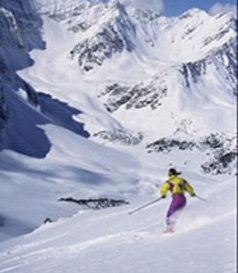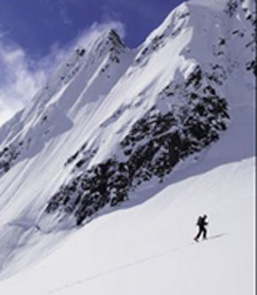

I love to go skiing. Being in the mountains feeds something in my feelings and I sense this response in the middle of my chest as a warmth and a joy.
In order to ski well I need to search at every moment for the right distribution of my weight, the appropriate posture, and a state of relaxation. My spine must be actively vertical, stretching, contributing to the alive feeling in my body.
My weight must be held away from the slope; I need to lean out from the side of the hill – my head knows this, but the position feels precarious, even though I understand at some level the science behind why it is the safest posture. When I lean out my weight forces the upward edge of the skis into the snow and this provides a very good grip. Conversely, although I might feel more comfortable leaning into the slope, as though hugging it for stability, this position shifts the skis so that they are not gripping the snow, and could slide away from under me. I said that I understand the theory, but only a part of me understands it and accepts it. This part is not just in the head, for years of skiing have allowed me to test out the truth of these ideas. It is an emotional part of me that does not fully accept them, that gets in the way.
A recreational skier rarely skis straight down a slope like a downhill racer, but turns from one direction to another, zigzagging down the slope, like tacking in a sailing boat. In order to turn I have to transfer my weight from one foot to the other and this changes the direction of the skis. At a certain point I am pointing directly downhill, an inevitable occurrence when turning, but a time of imagined peril.
When all this works in harmony, skiing is effortless; I glide and turn smoothly with a rhythm down the slope. The consequence of not attending to these factors is that skiing is more difficult, more dangerous and requires much more physical effort. When something happens to unsettle my equilibrium, I tense and the ease disappears. There are many things that can start this reaction. It might be a patch of ice, a group of people standing or skiing in front of me, the fear of facing down the mountain, a steep slope, bumps in the slope. The tension happens automatically; I seem to have no control over it. Sometimes, having seen it, I can regain the previous relaxed state while continuing to ski, at other times I need to stop and realign myself in order to continue in a better state.
I feel that I should be able to use this experience of skiing and relate it to the way I live in my wider life.
I know that I need to be able to let go, but I find that in most situations I cannot. I am always more or less tense. These habits of tension determine how my life is lived. I know that they are usually associated with and directly related to some emotional aspect of myself and the situation I am in.
I know that there is a right amount of effort for anything that I might be doing, but when I become more aware of myself I usually find that I am using too much physical effort; this is also related to tension in my body.
When I am skiing these factors are directly related to my immediate experience; in other circumstances this is not the case and I am reliant on becoming more aware and being able to see what is actually happening. Skiing has provided me with some clues, but it is more challenging to follow them up in the rest of my life.
Jane Gabb
